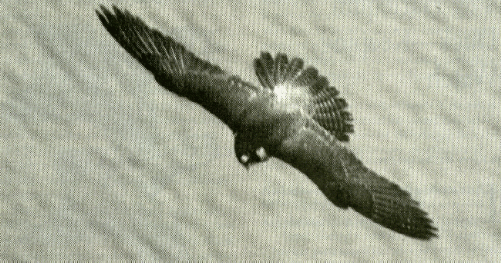
by: Mark Elderkin
WINTER 1995/96

A peregrine falcon defends nest with two chicks. Photo: Mark Elderkin
Foresters, geologists, biologists, and land-use planners are famous for inventing big "buzz" words. One of the biggest words to surface over the last two decades is Integrated Resource Management (IRM). Integrated Resource Management is the process that identifies and considers all resource use and management emphasis based on present uses, the mix of benefits produced, the continued capability of the land to produce benefits, and social preference. IRM produces a mosaic of single, concurrent, or sequential uses that may be few or many, and which meet agreed upon management objectives without unnecessarily impairing the land productivity. The approved pattern or sequence of uses provides a desired mix of benefits and may not necessarily provide the greatest financial return or the greatest unit output from any individual use. The goal of IRM is resource stewardship, guided by the principle of sustainable development.
IRM planning requires many types of complex information for sound, effective decision making. More often than not, land areas considered in IRM planning are large in size and the information required is extremely difficult to manage, understand, and summarize. Where are the various natural resources found in the province and who owns the land where they are found? How much wildlife habitat is protected from future development and how will development activities be coordinated? How much land is taken up by urban development, productive forest land, and agricultural land? Questions like these are now being answered using large computers and Geographic Information Systems (GIS) that simplify the task of summarizing complex information. GIS employs state-of-the-art computer technology and is a mapping tool that can be used for data analysis. The Department of Lands and Forestry' GIS contains information on the province's natural landscapes, land ownership, forests, water resources, and wildlife.
Until recently, if we wanted to know where all locations of the rare plant, plymouth gentian, or where active bald eagle nests were found in the province, several private individuals and government agencies would have to be contacted for this information. Those people recording this information frequently did so in relative isolation from one another and at different levels of detail. Therefore, it was difficult to know whether some records were duplicated.
During the last two years, funding provided through the federal/provincial Cooperative Agreement for Forestry Development (CAFD) has made it possible to improve our understanding of wildlife distributions and habitat associations of species in our provincial forests. The Nova Scotia Database of Significant Wildlife Habitats and Species (NSDSWHS) has been developed by regional biologists and Wildlife Division staff with the Nova Scotia Department of Lands and Forestry. Regional biologists throughout the province record observations of sensitive habitats that might be jeopardized by uncoordinated development activities on forest cover maps. Endangered species, species of concern, and species of special interest are identified through various sources and the exact geographic location is map referenced relative to the type of habitat where it is found. This data is later entered into GIS. Figure 1 provides an example of the referencing scheme employed in the NSDSWHS using a fictitious coastal island.
However, the NSDSWHS is not a magic "eye in the sky" and all the computers in the world cannot process data that is does not exist. Moreover, the NSDSWHS is a beginning, not an end unto itself. Much work still remains to be done. If the NSDSWHS is to be used successfully for IRM in the future, we need an ongoing commitment to update information at regular intervals. At the heart of every biological database of this type lies a core group of dedicated individuals who may know little or care nothing about computers. Yet these people are the eyes and keepers of the NSDSWHS system. Such databases are only as good as the quality and diversity of observers who have input.
They can be professional biologists, researchers, foresters, naturalists, trappers, birdwatchers, hunters, or fishermen. All have a dedicated commitment to conservation, stewardship, and sustainable use of our natural resources in common. Although the NSDSWHS is administered by the Department of Lands and Forestry, members of the public with demonstrated expertise and familiarity with the natural landscapes of the province are encouraged to contribute.
The NSDSWHS provides a computer-based set of tools for monitoring changes in the population of species and ecologically sensitive habitats. It provides a means to track changes in land-use practices and economic development activities over a long period of time. Perhaps most importantly, the NSDSWHS establishes a common pool of baseline information for making informed decisions on land use and meaningful predictions as to potential impacts on species that can be improved as better data becomes available. The NSDSWHS is a more reliable, credible, and efficient means of maintaining complex biophysical information because it establishes standards and procedures for maintaining biological data. Using this approach, we are building an inventory that provides a solid foundation for the future.